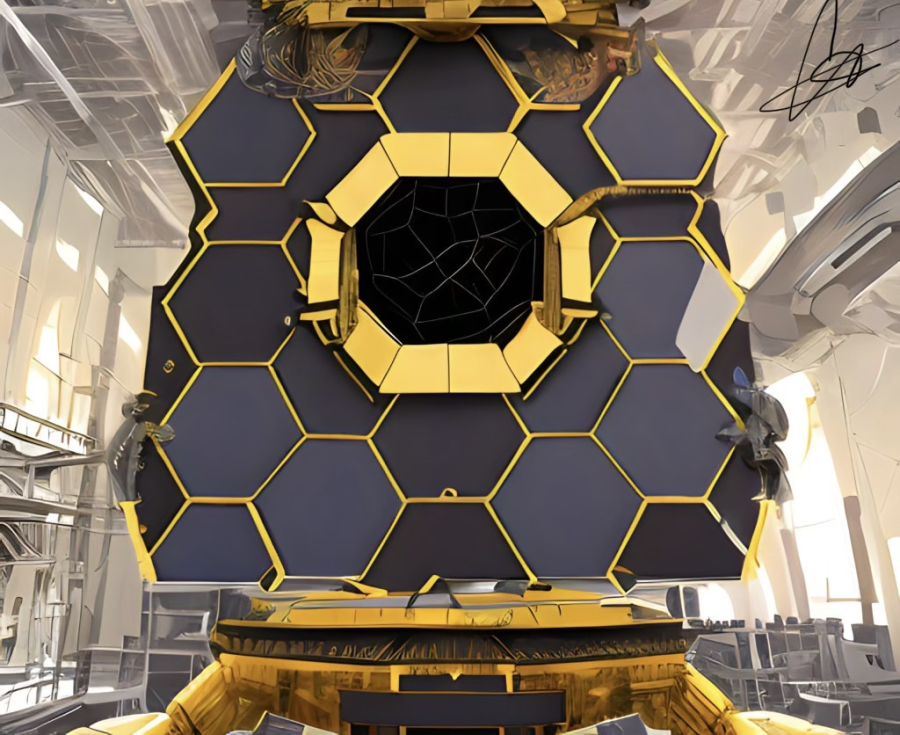Long Ago in a Galaxy Far Away: Space’s New Frontier Part II
January 20, 2023
The James Webb Space Telescope (JWST) has been breaking our expectations even before its launch. From its unfolding design to the complex deployment process, and now its breakthrough discoveries and in-depth images, the JWST will continue helping astronomers unlock the secrets of the universe.
The telescope was ready for full scientific operation on July 11, 2022, after its calibration process, and released its first images a few days later. Ever since then JWST has continued to send images back to Earth [1].
One of the primary goals of the telescope is to gauge a deeper understanding of galaxies in our universe. The infrared cameras on the JWST are able to detect redder wavelengths than the Advanced Camera for Surveys on the Hubble Space Telescope, JWST’s predecessor, which can detect visible light, ultraviolet light, and near-infrared light. As the universe expands, the wavelengths stretch more and more, shifting closer to the red spectrum resulting in something called the redshift. One study found that the JWST found 44 previously unknown galaxies ranging all the way back from 300 million years after the Big Bang. JWST’s discoveries strengthen the idea that many galaxies were forming during the cosmic dawn, a period that was 50 million years to a billion years after the Big Bang. Many stars, black holes, and galaxies were formed during that time. GLASS-z13 is believed to be the oldest galaxy, estimated to be 300 million years after the Big Bang, found by two teams, one led by Rohan Naidu at the Harvard Smithsonian Center for Astrophysics and another led by Marco Castellano from the Astronomical Observatory of Rome.
Furthermore, astronomers are able to look at the spectrographs that the JWST provides to understand the chemical components of galaxies like heavy elements such as oxygen. For example, the first stars in the universe are believed to be huge and made up of hydrogen and helium. The JWST has found that these heavier elements are present in early galaxies more than scientists had originally expected, prompting a greater rethinking of how fast stars form [2, 3]. With these observations in mind, astronomers are focusing on specific galaxies to explore different phenomena. SMACS 0732 is a small cluster of early galaxies that is able to bend the light from distant objects to make them more visible[2]. The Cartwheel Galaxy, formed from a high-speed collision and still managed to maintain the characteristics of the large, spiral galaxy. It’s caught in a transitory stage, leaving what will become a huge mystery [4]. Wolf-Lundmark-Melotte (WLM), a dwarf galaxy 3 million light years away found in the Cetus constellation, has provided scientists the chance to get a deeper understanding of how stars form. Due to its isolation, astronomers are able to test and focus on galaxy evolution and formation [5].
The images from JWST have also allowed many scientists to explore galactic structures. Because of the images taken by the Hubble, astronomers believed that distant galaxies, in comparison with nearby galaxies, were irregularly shaped due to interactions with neighboring galaxies. However, through the JWST, they instead found roughly up to 10 times more distant disk-shaped galaxies than originally expected, reshaping their view of the universe [2,3].
Just prior to Halloween, NASA released images of the eerie Pillars of Creation taken by the JWST. The Pillars of Creation is known to be the birthplace of many stars, located 6,500 light years away within the Eagle Nebula. The Hubble Space Telescope first captured the Pillars of Creation in 1995 and again in 2014. Now, the JWST offers a new look with its Mid-Infrared Instrument (MIRI). From its pictures, astronomers are able to detect the complex dust and gas, which are crucial for the formation of stars, that cloaks the Pillars of Creation. Within the blue-gray pillars, stars form as a result of the gas and dust coming together into significant mass forms that collapse due to their own gravitational attraction. Most of the stars themselves aren’t bright enough for their light to be caught. Out of the few that can be seen are the blue orbs: older stars that have shed off their gas and dust clouds, while the crimson orbs are the much younger stars. The red region in the background is where the dust is more diffused and cooler, and the darkest gray region is where the dust is the densest and coldest [5].
Within our own solar system, the JWST has offered a closer look at Saturn’s moon, Titan. As the only moon in our solar system to have a dense atmosphere and the only other planetary body that has rivers, lakes, and seas, there are many unexplained parts as to why Titan is the way it is. On November 4th, astronomers received images from the JWST’s Near Infrared Camera (NIR) that confirmed there were clouds in Titan’s atmosphere. Working with the Keck Observatory in Hawai’i, they compared the telescope images taken there with the JWST’s to examine whether the clouds could move or change shapes. Clouds can give greater insight into the airflow patterns in the atmosphere. Astronomers confirmed that there are seasonal patterns on Titan after seeing cloud shapes changing. They hope that the mid-infrared instruments can help further explain the complex gas composition of Titan and why it is the only moon with a dense atmosphere[6].
These are only a fraction of what the JWST has discovered and an even smaller glimpse of what the universe holds. Undoubtedly, the JWST has opened the doors to new discoveries, explanations of extraordinary phenomena, and even reevaluations of previous theories. With the opening of these doors having just begun, expect more fantastic findings to come along your way.
If you’d like to stay updated with the latest discoveries: https://www.space.com/news/live/james-webb-space-telescope-updates
Note: This is a sequel to a past article titled “Space’s New Frontier,” click below to read the past article.
https://www.ridgedevilsadvocate.com/stem/2022/02/15/spaces-new-frontier/
Sources:
[1]https://webbtelescope.org/contents/articles/webbs-first-year-of-science
[3]https://www.nature.com/articles/d41586-022-02056-5
[5]https://webbtelescope.org/contents/news-releases/2022/news-2022-053
[7]https://www.space.com/james-webb-space-telescope-wlm-dwarf-galaxy-image
[8]https://ceers.github.io/overview.html
For all images: https://webbtelescope.org/resource-gallery/images?Collection=First%Images

